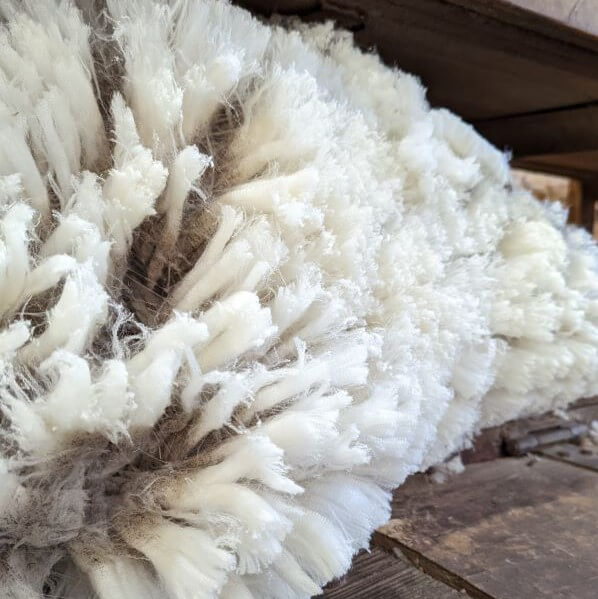
Producers with smaller quantities of wool may find benefits from ‘pooling’ wool together with other producers. This allows you and other producers to market your wool as a larger lot and target bigger buyers creating a win-win-win situation. When joining a pool, you will be give a date and drop-off location for your wool. Each pool has a secretary in charge of the logistics.
If you have wool to sell, absolutely! Anyone raising wool can join a Montana wool pool. Please contact your nearest pool to find out about delivery dates and pool membership. Many pools only have one drop-off day per year so call in the spring to be sure you have all the details for your preferred pool.
Yes, you must be a producer member of the Montana Wool Growers Association to participate in a wool pool. However, we make it super easy to join! If you’re new to a pool, you’ll fill out the standard contact information paperwork when dropping off your wool. Then, membership dues can be paid right here on our website. That’s it!
Wool marketing is harder on your own. If you run a smaller operation, you’ll find great benefits in pooling with other producers.
Reach buyers you couldn’t while flying solo
Many wool buyers want your high quality fiber, but they need more volume. When pooling wool, buyers get the quality they need and the quantity while supporting producers like you!
Wool pools bring together producers from various regions. This is just another great way to become active in the community and benefit from the comradery.
Thanks to access to more buyers, pooling provides some additional revenue directly to your bottom line. It’s just another great win for our members!
1.
Check out the pools in our directory and contact your nearest pool directly for dates and information.
Many pools only collect once per year, so be sure to contact them early spring so you don’t miss a drop-off deadline.
When the wool sells, you’ll receive your percentage of the profit minus your annual membership dues.
By Jim Drummond and Brent Roeder
The history of wool-marketing in the United States shows that a need for improved methods of marketing raw wool has always existed.
The need has been keen for the sheep producer who wants to receive the most dollars for his product and for the buyer or manufacturer who wants to obtain a high quality product. In the 1800’s sheep numbers increased rapidly throughout the United States. In the last half of that century with the development of the West and Northwest, a large part of the sheep and wool industry found itself removed from the major centers of manufacturing and consumption. With the increased distance between the point of production and the point of manufacturing, the marketing and transportation problems became more complex.
With the development of small flocks in the irrigated valleys of Montana, the need increased for a marketing agency close to home.
Certainly, there was an outlet for wool through larger cooperative organizations in the Central and Eastern states, but costs of shipping individual small lots to the co-ops was expensive and the returns were not immediately forthcoming. Although net returns from eastern co-ops to the producer were often greater, most producers felt that quick cash returns were more essential. In response to a request from the small wool producers in the Gallatin Valley, R. E. Bodley, County Extension Agent, called a meeting on May 22, 1920, to determine the feasibility of forming an organization to accumulate and market wool. About 60 small wool producers met and founded the “Gallatin County Sheep and Wool Growers Association.” At that same meeting, they adopted a constitution and set of by-laws which most Montana pools have since adopted. Within two months after the pool was organized, it received inquiries from many dealers and wool houses. By 1928, the pool was annually marketing over a quarter of a million pounds of wool.
In 1921, the Stillwater Woolgrowers Association was formed, and by 1950 seven more pools had been formed in Montana.
Since 1950 the number of small flocks has increased rapidly. The need for wool pools grew rapidly and in 1968, through the cooperation of the growers themselves and the Montana Woolgrowers Association, the Montana Wool Laboratory, and the Montana Cooperative Extension Service, 29 pools were active in the state. With the decline in sheep numbers since the end of their peak in the 1940s, there are currently 11 pools still active in Montana in 2023. Wool pools still serve a vital function in reducing transportation costs and giving smaller growers the advantage in today’s world market of economies of scale.
Reach out directly to the contact listed for the wool pool you’d like to join. Or send us a message through our contact form and we’ll get back to you with an answer.

Promote, Protect, and Support the Montana Sheep and Wool Industry.
PO Box 1693, Helena, MT 59624
406-442-1330
Copyright © Montana Wool Growers Association 2023 | Website Design and Development by Snowy Mountain Marketing | Privacy Policy